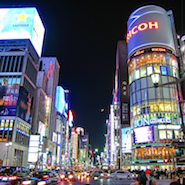- About
- Subscribe Now
- New York,
May 19, 2015

 Tokyo's Ginza district at night
Tokyo's Ginza district at night
Luxury retailers are looking to expand in the Americas and Asia Pacific, according to a new report by commercial real estate firm CBRE.
Across price points, six of the 15 cities with the largest number of retail arrivals in 2014 were in Asia, reflecting growing demand among consumers climbing the wealth ladder. While digital continues to occupy more brand and consumer attention, physical locations remain the chief place for purchases.
"The core elements of globalization, technology and demographic change, continue to have a dramatic impact on the business of retail," said Brandon Famous, senior managing director of retail occupier advisory and transaction services, CBRE, Los Angeles.
"Demographic shifts in many countries have resulted in changes in both spending power and shopping habits. Technology enables retailers to enter markets and evaluate performance more swiftly," he said.
“Consumer traveling patterns mean that many brands are well known before they even enter a market and the pent-up demand for the chance to purchase locally creates a ready-made market before entry.”
The "How Global is the Business of Retail?" report examined 334 leading international brand retailers that were identified as representative of the global retail community. For each of the retailers in the sample, research was undertaken to identify whether they had a presence in each of the 61 countries and 189 cities included in the study.
Ready-made
CBRE identifies globalization, demographic change and technology as the three main catalysts propelling retail expansion.
As consumers become more homogenized and brand awareness seeps across borders, ready-made opportunities emerge for retailers.
Similarly, as consumers in certain markets accrue wealth and increase their material expectations, their shopping tendencies will change.
Kenzo pop-up bus in Beijing
However, brands must realize that distinct cultural structures still exist across countries and merely importing a retail concept without modifying it will fail to attract consumers.
Underlying these shifts is the spread of technology, which gives consumers access to knowledge and empowers them to make informed decisions.
United States retailers were the most active in 2014, with 26 percent expanding both domestically and abroad. Italy, Britain, France, Spain, Japan, Sweden, Germany, Belgium and the Netherlands followed.
While retailers from the Americas are primarily looking abroad for expansion opportunities, brands in Asia and Europe see their regions as ripe for growth.
Burberry beauty box in Seoul
The hottest market across categories was Tokyo, with 63 entrants in 2014. CBRE notes that Japan's mixed economic signals, rising rents and an increased sales tax to 8 percent would suggest stymied interest from retailers. However, strong consumer demand has been enough to overcome difficulties.
Brands such as Tiffany & Co., Burberry and Moschino have announced plans for new stores in Tokyo, and Versace plans to re-enter the market this year.
While Singapore trailed Tokyo with 58 entrants, CBRE argues that declining visitors from Mainland China, weak retail sales and labor shortages will curb expansion this year.
Fragrance du Bois in Singapore
Abu Dhabi, United Arab Emirates, followed with 55 new retailers, and the report has nothing but good things to say about this thriving city. New retail spaces, expanded tourism, an affluent and growing youth and its cosmopolitan makeup all contribute to this assessment.
Other top cities include Taipei, Taiwan; Dubai, United Arab Emirates; Hong Kong; Moscow; Paris; Beijing and Doha, Qatar.
The report predicts that in the years to come peak luxury cities such as New York, London and Paris will be usurped by emerging players.
Inside-out
As retailers expand their retail footprints, the in-store experience is also rapidly changing.
Whether through smartphones, iBeacons or other technologies, retailers are ramping up their ability to pinpoint consumers and tailor shopping experiences, according to a report by Boston Retail Partners.
Ninety percent of retailers can identify consumers at the in-store check-out, up 17 percent from the year-ago period, but that is generally too late to make an impact, no matter how useful for profile-building and future engagement. In the next five years, there will be an 883 percent increase among retailers looking to identify consumers upon entering the store, according to the report (see story).
Also, over the next three years, 250 percent more retailers will transition to a single order management solution to support unified commerce across all channels, according to a report by Boston Retail Partners.
Before ecommerce took off in the 1990s and 2000s, the evolution of retail technology was stunted due to a lack of network technologies which caused a decentralized environment of data centers. Now that retail technology, especially mobile commerce, has advance and become commonplace, many retailers are still “chasing” omnichannel capabilities but have yet to fully integrate disparate legacy systems (see story).
"Consumers continue to view the physical store as their preferred mode of purchase and perhaps more importantly, as a point of social interaction," Mr. Famous said.
"[Also,] consumers view shopping as a leisure activity and the continued expansion of brands and the development/improvement of shopping locations gives them the opportunity to embrace this," he said.
Final Take
Joe McCarthy, staff reporter on Luxury Daily, New York
Share your thoughts. Click here